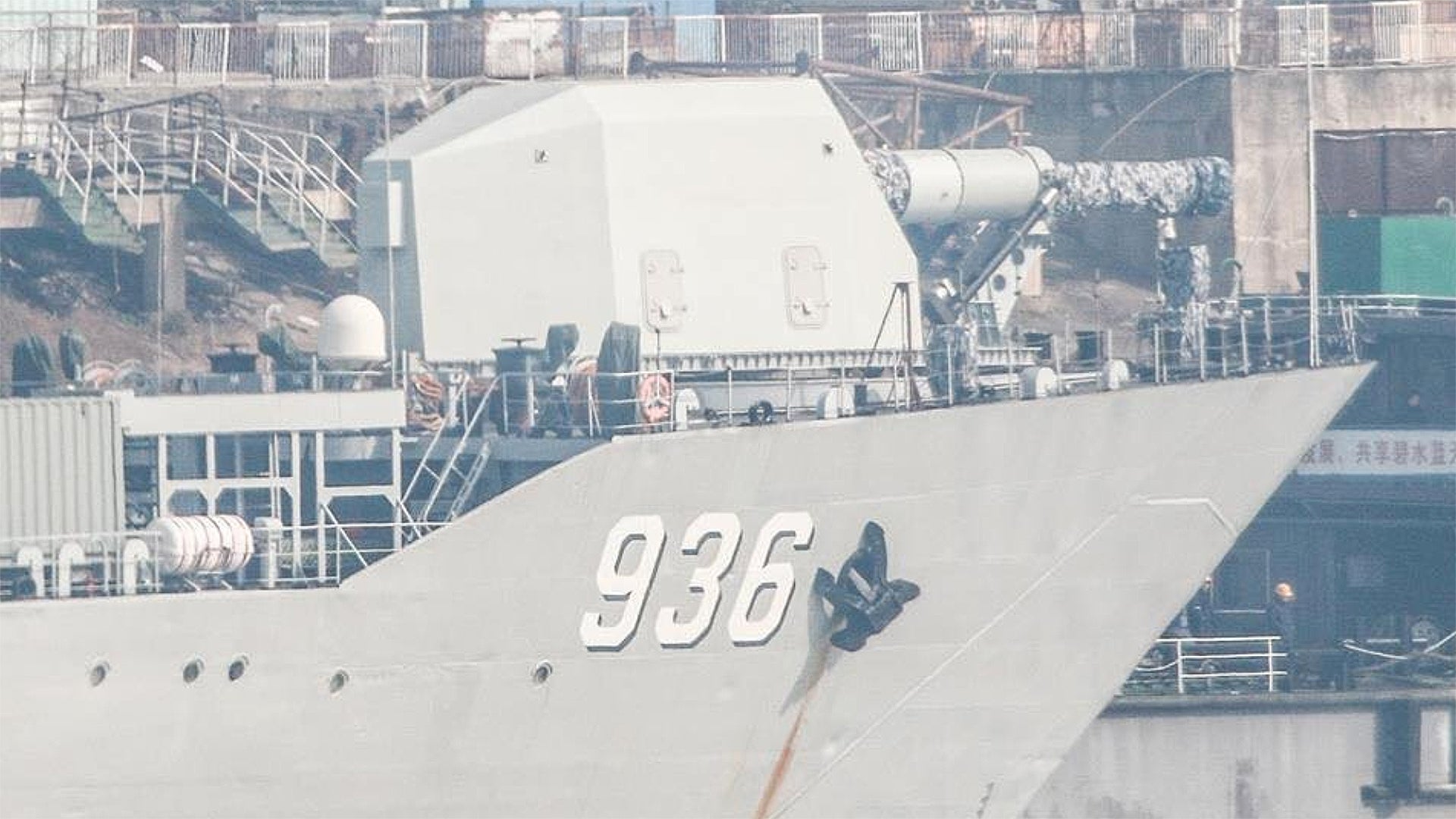We were among the first to report yesterday on images coming out of China showing the Haiyang Shan, a Type 072III-class landing ship equipped with what appeared to be an experimental electromagnetic railgun installed on its bow. Make sure to read our original post linked here for full background on this development, but now a new photo has emerged showing a highly detailed view of the massive deck gun.
Roughly a day after the first images came to light, it seems as if the consensus is that this is indeed a railgun or some sort of hybrid prototype design. No other existing weapon or known planned system matches the size of the gun’s massive cupola no the extremely fat profile of its barrel. The closest some could find was the Type 055 destroyer’s H/PJ38 130mm deck gun or the PLZ05 155mm self-propelled howitzer’s gun system, but neither of these are anywhere near the scale as the system installed on the Haiyang Shan.
Others have floated the possibility that this installation could be some sort of large caliber naval mortar system, but the size of the turret, its elaborate barrel system, and the overall configuration of temporary infrastructure installed on the ship doesn’t seem to support that idea, not to mention such a system would have debatable utility. Still we can’t totally rule it out.
(Tweet translation: The reason for using the 072 type landing ship is the same as the above 2.The deck of the type 072 is large, can be installed a number of power generation equipment, and can also be installed in a wide variety of facilities because it has a large hangar inside. The part reflected in the Photograph: the control device from the left of the deck, the generator. A new observation room and a facility were installed to observe the test on the bridge.)
If this is indeed a railgun, the idea that China could put a weapon as advanced as this to sea—even in an experimental form—should serve as a huge gut check for the Pentagon which has chronically underestimated the Beijing’s ability to field advanced weapons over the last decade.
Some good could come out of such a development though. After toiling with EM railgun technology for a decade, the U.S. Navy could double-down on its own efforts to mature the technology into an operational format—or at least one that can finally be tested at sea.
In 2014, it was planned that a railgun was going to be deployed for tests aboard a Spearhead class high-speed logistics ship in 2017, but then it seemed that the Navy’s brass wanted to bypass at sea testing altogether. Navy Admiral Pete Fanta, then the director of surface warfare and now the head of warfare integration, told Defense News in 2016:
“I would rather get an operational unit out there faster than do a demonstration that just does a demonstration.”
Such logic seems extremely questionable especially for such a cutting-edge technology. The Pentagon has been bogged down by far less ambitious “concurrent” development, testing, and production projects recently, leaving the idea that a railgun could follow a similar path and be successful as almost a laughable proposition.
But the ambitions of admirals and the realities of the immature technology seems to have caught up with the Navy over the last year. We wrote the following in a piece on the Navy’s railgun project in March of 2017:
In spite of these developments, the Navy hasn’t changed its timeline for when the electrically-powered cannons will be operational since at least 2015, according to a March 2017 report from the Congressional Research Service. The service still reportedly expects the guns to be in action by 2025. The potential for more difficulties – old or new – has not been lost on members of Congress, many of whom are looking to expand the defense budget, but have no interest in programs that might never produce results.
“Although the Navy in recent years has made considerable progress, a number of significant development challenges remain,” CRS noted in its review. “Overcoming these challenges will likely require years of additional development work, and ultimate success in overcoming them is not guaranteed.”
Recently it has been widely reported that the Navy has quietly stepped away from their railgun dreams due to the huge technological hurdles that still remain. Over the last month we have reached out to the Office of Naval Research time and again to confirm that this is in fact the case without response. If indeed the Navy has recently sidelined their railgun project, its status could change drastically due to these recent foreign developments. And this prompts another question—did American intelligence services see China’s breakthroughs in railgun technologies coming or not?
We have contacted the Pentagon for comment and we will let you know what we hear back.
Contact the author: Tyler@thedrive.com
